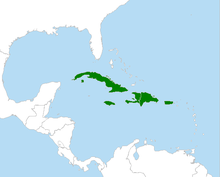Todus
| Todus | |
|---|---|
 |
|
| Jamaican tody (Todus todus) | |
| Scientific classification | |
| Kingdom: | Animalia |
| Phylum: | Chordata |
| Class: | Aves |
| Order: | Coraciiformes |
| Family: | Todidae |
| Genus: |
Todus Brisson, 1760 |
| Species | |
|
See text |
|
 |
|
| Global range (In green) | |
See text
Todus is a genus of birds in the family Todidae, the todies, found in the Caribbean. It is the only extant genus with the family Todidae. The five species are small, near passerine birds of the forests of the Greater Antilles: Puerto Rico, Jamaica, and Cuba, with adjacent islands, have one species each, and Hispaniola has two, the broad-billed tody in the lowlands (including Gonâve Island) and the narrow-billed tody in the highlands.
Five species are recognized:
Todies range in weight from 5 to 7 g and in length from 10 to 11.5 cm. They have colourful plumage and resemble kingfishers in their general shape. They have green heads, backs and wings, red throats (absent in immature Puerto Rican, broad-billed, and narrow-billed Todies) with a white and blue-grey stripe on each side, and yellow undertail coverts; the colour of the rest of the undersides is pale and varies according to species. The irises are pale grey. They have long, flattened bills (as do many flycatching birds) with serrated edges; the upper mandible is black and the lower is red with a little black. The legs, and especially the feet, are small. Todies are highly vocal, except that the Jamaican tody seldom calls in the non-breeding season (August to November); they give simple, unmusical buzzing notes, beeps, and guttural rattles, puffing their throats out with every call. Their wings produce a "strange, whirring rattle", though mostly when courting or defending territory in the Puerto Rican tody.
Todies are generally sedentary; the longest single flight known for the broad-billed tody is 40 m. Their activity is greatest in the morning when sunny weather follows rain, and in March and September.
Like most of the Coraciiformes, todies nest in tunnels, which they dig with their beaks and feet in steep banks or rotten tree trunks. The tunnel is 30 cm long in the Cuban and narrow-billed Todies, 30 to 60 cm in the broad-billed tody, and ends in a nest chamber, generally not reused. They lay about four round white eggs in the chamber. Both parents incubate but are surprisingly inattentive to the eggs. The young are altricial and stay in the nest until they can fly. Both parents also care for the nestlings, much more attentively; they may feed each chick up to 140 times per day, the highest rate known among birds.
...
Wikipedia
